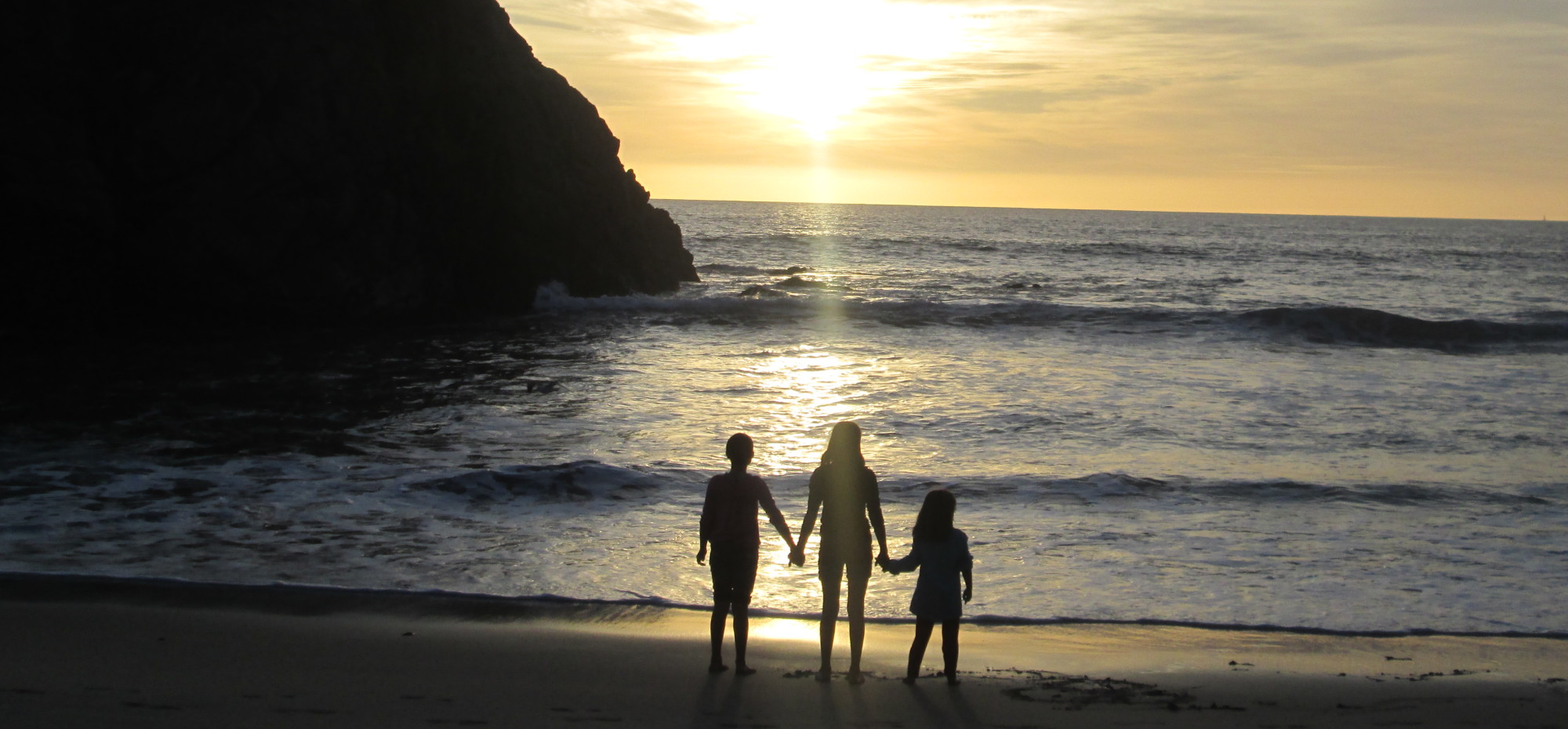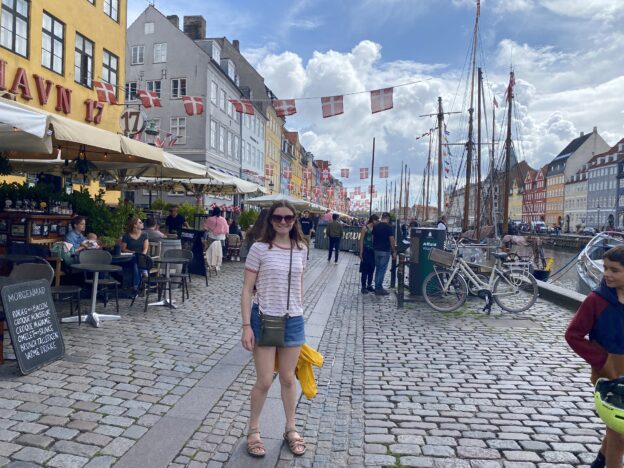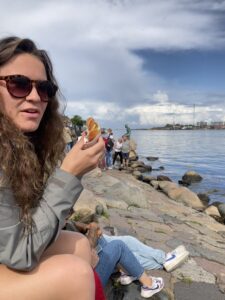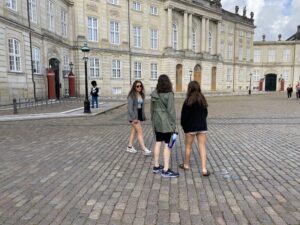 I’ve been a little off my game on this Copenhagen leg of the trip. We’ve all been a little tired, and I’ve been feeling like I was coming down with something. (I thought it was Zoe’s cold, but — spoiler alert — it later turned out to be Covid, which I had successfully avoided for over three years. I blame the stress caused by SJ Trains.) As the family cruise director, I think my lack of energy caused a little bit of aimlessness and difficulty deciding what to do. For today, our last day, I figured I needed to rally and come up with a clearer plan — and fortunately we were able to find a cluster of activities all in the same
I’ve been a little off my game on this Copenhagen leg of the trip. We’ve all been a little tired, and I’ve been feeling like I was coming down with something. (I thought it was Zoe’s cold, but — spoiler alert — it later turned out to be Covid, which I had successfully avoided for over three years. I blame the stress caused by SJ Trains.) As the family cruise director, I think my lack of energy caused a little bit of aimlessness and difficulty deciding what to do. For today, our last day, I figured I needed to rally and come up with a clearer plan — and fortunately we were able to find a cluster of activities all in the same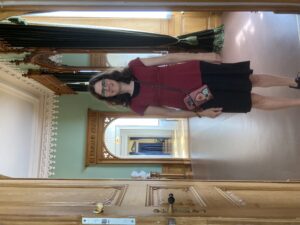 neighborhood.
neighborhood.
We decided to continue our strategy of energy conservation, and again were able to successfully navigate the bus system. (This is more due to how clear, helpful, and omnipresent the buses are here, rather than any particular skill on our part. However, we did feel a little cooler when the group of tourists we were standing among all got onto one of those hop on/hop off red tourist buses, leaving us alone to get on the regular city bus.)
First on the agenda: Amalienborg Palace. There are a few different palaces in the 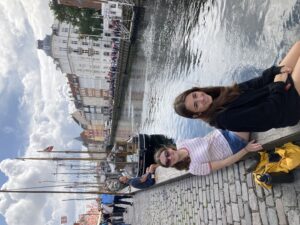 city and we didn’t have time to do all of them. We picked this one pretty much just because it was in the neighborhood of some other things we wanted to see. It’s the current residence of the Swedish royal family, and was worth a quick stop. (We had another mystery adventure envelope for this place, but were too disheartened from our prior experience to even pull it out.)
city and we didn’t have time to do all of them. We picked this one pretty much just because it was in the neighborhood of some other things we wanted to see. It’s the current residence of the Swedish royal family, and was worth a quick stop. (We had another mystery adventure envelope for this place, but were too disheartened from our prior experience to even pull it out.)
Next up: cardamom buns. These had been recommended to us as a Danish delicacy by our friends the Palmers, who visited recently. They proved to be slightly more difficult to find than we expected, and we had also not gotten what you would call an early start — so by the time we had secured them, it was just about lunchtime. So the buns went into a box to enjoy later, and we started casing the lovely historic harborfront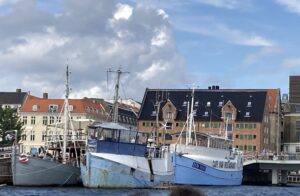 neighborhood of Nyhavn for a suitable restaurant. We quickly found that lovely harborfront neighborhood restaurants are (a) heavily dominated by fish, which at least one of our party won’t eat, and (b) not the most affordable.
neighborhood of Nyhavn for a suitable restaurant. We quickly found that lovely harborfront neighborhood restaurants are (a) heavily dominated by fish, which at least one of our party won’t eat, and (b) not the most affordable.
Eventually we found an Asian restaurant off the main strip. The main thing we’ll remember about it is the waiter, who was from 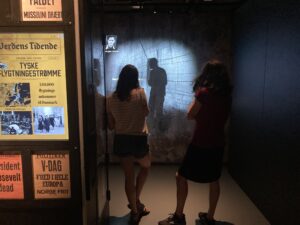 Turkey and was single-handedly serving the whole place with much energy and enthusiasm. He seemed to have a bit of a gambling problem, and was very interested in the soccer game that Nadia was trying to watch on her phone. I’m not sure if he’d already placed a bet on it, or whether he called his bookie on the spot, but he was very anxious that two goals be scored by Nadia’s team. Both he and Nadia were very celebratory when this happened.
Turkey and was single-handedly serving the whole place with much energy and enthusiasm. He seemed to have a bit of a gambling problem, and was very interested in the soccer game that Nadia was trying to watch on her phone. I’m not sure if he’d already placed a bet on it, or whether he called his bookie on the spot, but he was very anxious that two goals be scored by Nadia’s team. Both he and Nadia were very celebratory when this happened.
Next up was a museum that the kids had picked out after reading about it on the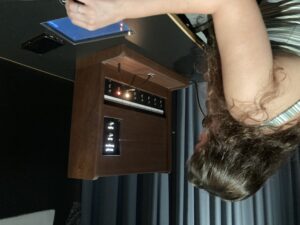 Copenhagen Card website. The Museum of Danish Resistance, detailing the history of Denmark during WWII, was not exactly an obvious choice, but it was actually a very cool place. It was in a dim, high-ceilinged basement and consisted of a series of audio tours, accompanied by flicking black and white movie images projected on the concrete
Copenhagen Card website. The Museum of Danish Resistance, detailing the history of Denmark during WWII, was not exactly an obvious choice, but it was actually a very cool place. It was in a dim, high-ceilinged basement and consisted of a series of audio tours, accompanied by flicking black and white movie images projected on the concrete
walls. It followed the story of five different Danes during the war as well as the conditions of the country as a whole. There were fun hands on activities like eavesdropping on conversations with an old-fashioned telephone switchboard, and decoding secret messages. (Also, we later discovered that while in the windowless basement we seemed to have avoided a substantial rainstorm.)
The museum was right next to a large waterfront park, with an imposing fountain, pieces of an old fort, and a short walk to the famous Little Mermaid statue. (This, as the Palmers had warned us, was not all that impressive and was also swarmed with tourists, but the walk there was pleasant and it proved to be a nice place to take a rest and enjoy our cardamom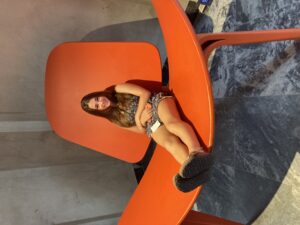 buns.)
buns.)
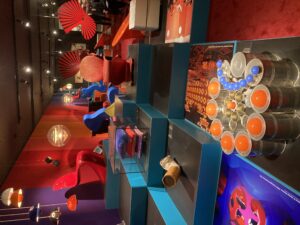 Our planned dinner destination was somewhat nearby, but we weren’t ready for dinner yet. Conveniently, there was a cool-sounding museum nearby, and another right near our dinner spot. Better yet, Thursday was the one night of the week that the latter museum was open late, so we’d have time to do both and then roll into the dinner hour.
Our planned dinner destination was somewhat nearby, but we weren’t ready for dinner yet. Conveniently, there was a cool-sounding museum nearby, and another right near our dinner spot. Better yet, Thursday was the one night of the week that the latter museum was open late, so we’d have time to do both and then roll into the dinner hour.
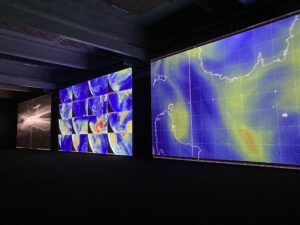 The first was the Design Museum of Denmark, and we all really liked it. The exhibits were so diverse that it’s hard to sum them up. It was a cool mixture of modern art, interior design, and social commentary, and well worth the time we spent there.
The first was the Design Museum of Denmark, and we all really liked it. The exhibits were so diverse that it’s hard to sum them up. It was a cool mixture of modern art, interior design, and social commentary, and well worth the time we spent there.
The second museum was on the other side of the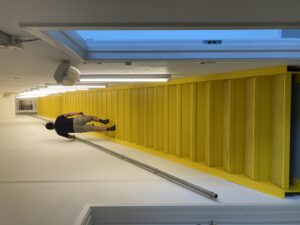 harbor, so we had to take a ferry to get there. Fortunately, as with all the other public transport that we’ve found here, this was well-run and easy to navigate. It took us quite some time of scratching our heads and squinting at the signs to feel confident that we were going in the right direction, but we could actually see the sign from across the harbor so we really had no excuse for this other than tiredness and paranoia.
harbor, so we had to take a ferry to get there. Fortunately, as with all the other public transport that we’ve found here, this was well-run and easy to navigate. It took us quite some time of scratching our heads and squinting at the signs to feel confident that we were going in the right direction, but we could actually see the sign from across the harbor so we really had no excuse for this other than tiredness and paranoia.
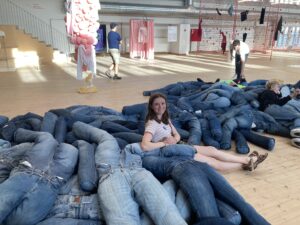 On the other side of the harbor, we found ourselves in a strange post-industrial part of town. It seems to be in the process of gentrifying, but hasn’t quite gotten then yet. The Copenhagen Contemporary museum was at the far end of a dreary street mostly populated by deserted factories, and did not at all seem like an area where you’d find a tourist attraction. But we found this fit well with the vibe of the museum, which itself was built in a former welding factory. This is another one that is hard to describe. There were exhibits consisting of huge movie screens, giant sculptures, a
On the other side of the harbor, we found ourselves in a strange post-industrial part of town. It seems to be in the process of gentrifying, but hasn’t quite gotten then yet. The Copenhagen Contemporary museum was at the far end of a dreary street mostly populated by deserted factories, and did not at all seem like an area where you’d find a tourist attraction. But we found this fit well with the vibe of the museum, which itself was built in a former welding factory. This is another one that is hard to describe. There were exhibits consisting of huge movie screens, giant sculptures, a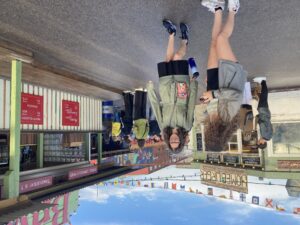 pile of stuffed jeans for lounging, and much more. It was a nice museum for avoiding overwhelm, because most of it was large rooms with only one or two things to look at.
pile of stuffed jeans for lounging, and much more. It was a nice museum for avoiding overwhelm, because most of it was large rooms with only one or two things to look at.
We waited in line for this one “experiential” exhibit, not knowing what to expect. After going into an antechamber and replacing our shoes with white cotton booties, we (along with 4 other people) climbed a set of lighted stairs and emerged into a cornerless tunnel flooded with different colors of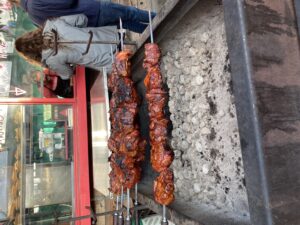 light. We were left to experience this for about 10 minutes, as the colors changed around us. It was quite a unique experience! Unfortunately no photos were allowed, but we would recommend a visit if you ever find yourself in Copenhagen.
light. We were left to experience this for about 10 minutes, as the colors changed around us. It was quite a unique experience! Unfortunately no photos were allowed, but we would recommend a visit if you ever find yourself in Copenhagen.
Finally, dinner time! On yet another recommendation from the Palmers, we were traveling to Reffen, just down the street from the museum. It’s hard to describe this place. It’s a little industrial looking shanty town, with winding alleys lined with shacks selling all kinds of delicious food from around the 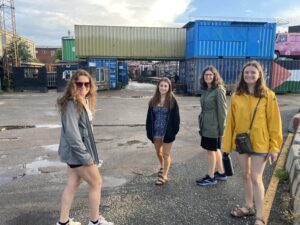 world. We were having trouble deciding if it really was a ramshackle place that sprung up in old shipping containers and the like, or whether it was carefully constructed to look that way. We decided it was probably the latter, but it was so well done that it was hard to be sure. Several of us were reeled in immediately by the burrito place that had a spit out front of pork, roasting tantalizingly on a rotisserie. Others got tofu and noodles, sandwiches, chicken satay, ice cream — it was a feast across the board.
world. We were having trouble deciding if it really was a ramshackle place that sprung up in old shipping containers and the like, or whether it was carefully constructed to look that way. We decided it was probably the latter, but it was so well done that it was hard to be sure. Several of us were reeled in immediately by the burrito place that had a spit out front of pork, roasting tantalizingly on a rotisserie. Others got tofu and noodles, sandwiches, chicken satay, ice cream — it was a feast across the board.
We were thrilled when we found that there was a ferry route traveling most of the way back to our hotel, but alas — after waiting for a while and squinting at the signs again, we eventually determined the ferries were no longer running. (We don’t really blame ourselves for how long this took, because while we were waiting about a dozen other people lined up behind us. We assumed they knew what they were doing, and apparently they (unwisely) assumed the same of us.) So it was back to the bus again, for one last night in our hostel.
